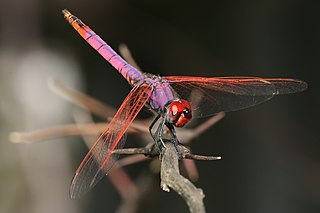
Odonata is an order of predatory flying insects that includes the dragonflies and damselflies. The two major groups are distinguished with dragonflies (Anisoptera) usually being bulkier with large compound eyes together and wings spread up or out at rest, while damselflies are usually more slender with eyes placed apart and wings folded together along body at rest. Adult odonates can land and perch, but rarely walk.

The petaltails of the family Petaluridae are among the most ancient of the extant true dragonflies, having fossil members from as early as the Jurassic, over 150 million years ago. A 2024 molecular phylogeny found that the petaltails comprise two clades, a Gondwanan clade and a Laurasian clade. Their divergence time was estimated at 160 million years ago.

The Pseudostigmatidae are a family of tropical damselflies, known as helicopter damselflies, giant damselflies, or forest giants. The family includes the largest of all damselfly species. They specialize in preying on web-building spiders, and breed in phytotelmata, the small bodies of water held by plants such as bromeliads.

Amanipodagrion gilliesi is a species of damselfly. Its monotypic genus Amanipodagrion was formerly in the subfamily Argiolestinae of the flatwing damselfly family (Megapodagrionidae). As a result of molecular phylogenetic studies by Bybee et al. in 2021, it is now in its own family, Amanipodagrionidae.

Arabicnemis is a monotypic genus of damselflies in the family Platycnemididae containing the single species Arabicnemis caerulea. It is known commonly as the powder blue damselfly. It is endemic to the Arabian Peninsula, where it occurs in Oman, the United Arab Emirates, and Yemen.
Calopteryx exul is an endangered species of damselfly in the family Calopterygidae. It is endemic to Algeria, Morocco, and Tunisia. The species lives in isolated subpopulations within fragmented habitats, and the largest populations found were located in Northeast Algeria. Their preferred habitat is lotic systems, featuring fast and shallow water, sparse vegetation, and a low amount of shade.

Mesocnemis is a genus of African damselflies in the white-legged damselfly family (Platycnemididae). They are commonly known as Riverjacks.

Paraphlebia is a genus of flatwings in the damselfly family Thaumatoneuridae. It was formerly in the subfamily Argiolestinae of the family Megapodagrionidae, but was moved to the family Thaumatoneuridae as a result of molecular phylogenetic studies by Dijkstra et al. in 2013.

Thaumatoneura inopinata is a species of damselfly, sometimes called the cascade damselfly or giant waterfall damsel, and the only member of the genus Thaumatoneura. It is unusual in flying among the falling water and spray from waterfalls in moist tropical or subtropical forests in Costa Rica.

Trithemis is a genus of dragonflies in the family Libellulidae. They are commonly known as dropwings. There are over 40 species, mainly from Africa; two are endemic to Madagascar, and five can be found in Asia. They are found in a wide variety of habitats; some species being adapted to permanent streams in forests, and others being capable of breeding in temporary pools in deserts.

Thaumatoneuridae is a family of damselflies in the order Odonata. There are at least three genera and about five described species in Thaumatoneuridae.

Indosticta deccanensis, the saffron reedtail, is a damselfly species in the family Platystictidae. It is endemic to Western Ghats in India.

Calopterygoidea is a superfamily of damselflies in the order Odonata.
Protolestes is a genus of flatwings in the damselfly order Odonata. There are about eight described species in Protolestes.
Allocnemis abbotti, formerly Chlorocnemis abbotti, is a species of white-legged damselfly in the family Platycnemididae. It is found in Kenya, Malawi, and Tanzania. Its natural habitats are subtropical or tropical moist lowland forests, rivers, intermittent rivers, and freshwater springs. It is threatened by habitat loss.
Allocnemis pauli is a species of white-legged damselfly in the family Platycnemididae. It is found in the Democratic Republic of the Congo, Kenya, Nigeria, and Uganda. Its natural habitats are subtropical or tropical moist lowland forests, rivers, intermittent rivers, and freshwater springs.
Mesopodagrion is a genus of flatwings in the damselfly order Odonata. There are two described species in Mesopodagrion.
Tatocnemis is a genus of flatwings in the damselfly order Odonata. There are about 10 described species in Tatocnemis.

Philosinidae is a family of damselflies in the order Odonata. There are at least 2 genera and about 12 described species in Philosinidae, found mainly in southeast Asia.
Pseudolestes mirabilis is a species of damselfly. As a result of molecular phylogenetic studies by Bybee et al. in 2021, its monotypic genus Pseudolestes is now in its own family, Pseudolestidae.














